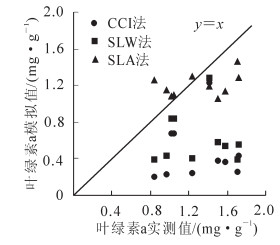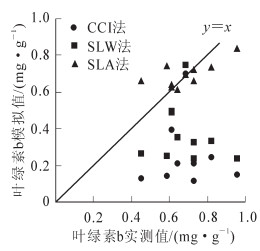-
叶绿素是光合作用的重要物质基础,叶绿素含量常作为评价植物光合作用能力、突变、环境胁迫和营养状态的一个重要指标[1]。目前,测定叶绿素含量的方法主要有2种:一种是萃取法,另外一种是借助叶绿素仪获得叶绿素指数。采用叶绿素仪、萃取法测定叶片叶绿素的原理不同,前者是通过在红光和红外光2个波段激发光源时的光学吸收率,测量被测物的叶绿素相对含量,是一个无量纲的比值,而后者是单位质量叶片所含叶绿素质量。叶绿素仪因其测定叶绿素具有快速、无损、便捷的优势而被广泛应用;萃取法则需损坏叶片,操作繁杂,工作量大,测定时间长,在野外测定难度较大,因此不适合野外工作。目前,叶绿素仪CCM-200已广泛应用于农林作物的叶绿素指数测定,已有研究发现园林树木[2]、果树[3],玉米Zea mays[4],水稻Oryza sativa[5-7],小麦Triticum aestivum[8],烤烟Nicotiana tabacum[9]等多种植物的叶绿素指数(chlorophyll content index,CCI值)与叶绿素质量分数存在极显著正相关关系,但文献中提出的叶绿素指数与叶绿素质量分数的线性模型均针对单一植物,模型参数差异大,没有通用于各种不同植物的模型[5-11]。分析叶绿素仪CCM-200测量叶绿素的原理,其测得的叶绿素指数未反映叶片厚度对测算叶绿素质量分数的影响,而已有的文献中建立的叶绿素估算模型也仅用到了叶绿素指数,并未考虑叶厚度的影响[9, 11-12]。因此,本研究通过分析不同树种叶绿素指数、叶片厚度与叶绿素质量分数之间的关系,建立一个适用于不同树种叶绿素质量分数估测的通用模型,以充分发挥叶绿素仪的作用,避免采用繁杂的萃取法,为在野外测量森林中不同树种叶片的叶绿素质量分数提供方便、快速测量方法,同时弥补叶绿素指数未反映叶片厚度对测量叶绿素质量分数的影响。
-
试验地点位于浙江省临安市浙江农林大学东湖校园植物园,30°15′38.13″~30°15′43.60″N,119°43′11.41″~119°44′0.54″E,地处中亚热带季风气候区南缘,属季风型气候,温暖湿润,光照充足,雨水充沛,四季分明,年均降水量为1 613.9 mm,降水日为158 d,无霜期年平均为237 d。
-
2013年6月在浙江农林大学东湖校园植物园内选取校园中常见树种,如青冈Cyclobalanopsis glauca,苦槠Castanopsis sclerophylla,樟树Cinnamomum camphora,广玉兰Magnolia grandiflora等常绿阔叶树种和黄山栾树Koelreuteria integrifoliola,白玉兰Magnolia heptapeta,无患子Sapindus mukorossi,鹅掌楸Liriodendron chinensis,日本晚樱Prunus serrulata等落叶阔叶树种的叶片进行采样。各树种采集树叶3片·株-1,尽量选择不同生长状态的叶片,如嫩叶、成熟叶和老叶等,共采集树叶50片。
-
使用OPTI-SCIENCE生产的CCM-200型叶绿素仪进行测定,对样本树叶分别测量10次·叶-1,测量部位均匀分布于叶片,取平均值作为该叶片的叶绿素指数。
-
叶绿素测定采用溶液萃取法,萃取的溶液为以V(乙醇):V(丙酮):V(水)=4.5:4.5:1.0的比例进行配制。用手握式打孔机对样本叶片打孔,得到的圆片剪碎后称取0.1 g放置在25 mL的萃取液中,再放置黑箱24 h后,用分光光度计测量波长649 nm和665 nm的吸光光度值D(λ)。根据测定的吸光光度值D(λ),按以下公式计算单位质量叶片中叶绿素质量分数[12]:C叶绿素a(mg·g-1)=[13.95D(665)-6.88D(649)]×V/(W×1 000)。C叶绿素b(mg·g-1)=[24.96D(665)-7.32D(649)]×V/(W×1 000)。C总叶绿素=C叶绿素a+ C叶绿素b。其中:V为叶绿素提取液体积(mL),D(649)为叶绿素提取液在649 nm处的吸光度值,D(665)为叶绿素提取液在665 nm处的吸光度值,W为称取的叶片质量,本次实验为0.10 g。
-
比叶质量(specific leaf weight, SLW)是指单位面积的叶片质量(干质量或鲜质量);其倒数称为比叶面积(specific leaf area,SLA)是指单位质量的叶片面积。用手握式打孔机得到圆片20个·叶片-1`,单个圆片的直径为6 mm,用分析天平称其质量,求得每片叶片的比叶质量(g·cm-2)和比叶面积(cm2·g-1)。
-
将获取的数据输入Excel中,以不同自变量分别建立模型估算叶绿素叶绿素a,叶绿素b和总叶绿素含量,并作线性回归分析。
-
本实验共测得50个样本,其中40个用来建立叶绿素质量分数的线性估计模型,10个用于模型检验。叶绿素指数、比叶质量、比叶面积和叶绿素质量分数的测定结果统计信息见表 1,各项指标的变化幅度都较大。
表 1 40个样本数据统计
Table 1. 40 samples statistical data
项目 叶绿素
指数比叶质量/
(g.cm-2)比叶面积/
(cm2·g-1)叶绿素a /
(mg·g-1)叶绿素b/
(mg·g-1)总叶绿素/
(mg·g-1)最大值 109 0.038 89.857 2.329 1.388 3.401 最小值 1 0.011 26.022 0.072 0.096 0.168 平均值 22 0.021 52.396 1.028 0.605 1.632 方差 528 4.678E-05 270.126 0.402 0.113 0.927 变异系数 1.057 0.326 0.314 0.617 0.555 0.590 -
从表 2可见:叶绿素质量分数与叶绿素指数之间存在正相关关系。叶绿素指数作为自变量建立的线性模型分别预测叶绿素a,叶绿素b和总叶绿素质量分数,模型的决定系数(R2)分别为0.605,0.618和0.612,相关性较低,F检验仅达到显著,不能较好地估测叶绿素质量分数。
表 2 不同自变量建立的叶绿素估测模型
Table 2. Estimation chlorophyll content models of different variable
自变量 线性方程 R2 Rmse F检验 叶绿素指数 C 叶绿素a=0.029 8x1 0.605 0.757 * C叶绿素b=0.017 0x1 0.618 0.427 * C总叶绿素=0.0470x1 0.612 1.178 * 叶绿素指数和比叶质量 C叶十绿素a=0.018 0x1+22.029 0x2 0.675 0.109 ** C 叶绿素b=0.009 7x1+14.310 0x2 0.707 0.374 ** C 总叶绿素=0.028 0x1+36.348 0x2 0.689 1.055 ** 叶绿素指数和比叶面积 C叶绿素a=0.015 0x1+0.014 0x3 0.869 0.437 ** C叶绿素b=0.009 0x1+0.008 0x3 0.893 0.226 ** C总叶绿素=0.024 0x1+0.022 0x3 0.881 0.652 ** 说明:x1表示叶绿素指数,x2表示比叶质量,x3表示比叶面积,*置信度为0.05时显著,**置信度为0.01时显著。R2和Rmse的计算公式如下: ${R^2}=\frac{{{{\left[ {\sum\limits_{i=1}^n {\left({{x_i} -\bar x} \right)\left({{y_i} -\bar y} \right)} } \right]}^2}}}{{\sum\limits_{i=1}^n {\left({{x_i} -\bar x} \right)} \sum\limits_{i=1}^n {\left({{x_i} -\bar y} \right)} }}, {R_{{\rm{mse}}}}=\sqrt {\frac{{\sum\limits_{i=1}^n {{{\left({{x_i} -{y_i}} \right)}^2}} }}{n}} $。其中xi是实测值,yi是预测值,$ {\bar x}$是实测平均值,${\bar y}$是预测平均值,n表示样本容量,i=1,2, 3, ..., n。 -
当模型加入比叶质量或比叶面积参数后,叶绿素估算精度明显提高,特别是比叶面积与叶绿素指数共同估测叶绿素质量分数时,其相关性和估测精度都是最高的。比叶质量、比叶面积均与叶绿素质量分数反应正相关,说明叶片的厚度与叶绿素质量分数存在正相关关系。即当叶绿素指数一定时,叶片越厚,叶绿素质量分数越高。
-
根据不同自变量来估测叶绿素质量分数模型,结果如表 2所示。由表 2中可知:决定系数(coefficient of determination,R2)最大的模型是由叶绿素指数与比叶面积建立的叶绿素质量分数估测模型,其均方根误差(root mean standard error, Rmse)也相对较小,说明此模型估测的叶绿素质量分数精度较高。比叶面积参与估测叶绿素a,叶绿素b和总叶绿素质量分数的3个线性模型中,叶绿素b的预测精度最高,即叶绿素指数和比叶面积对叶绿素b的敏感性高于叶绿素a和总叶绿素质量分数。
-
采用预测值和观测值之间的R2和Rmse对模型进行验证。R2用于分析预测值和实测值之间的符合度,Rmse用于评价预测值和实测值之间的精确度。
将剩余的10个样本值用于检验,根据叶绿素指数来估测叶绿素a,叶绿素b和总叶绿素质量分数的线性模型,所得预测值与实测值比较,比较结果见表 3和图 1~3。图 1~3中叶绿素指数法表示的是以叶绿素指数为自变量的线性模型预测的叶绿素与叶绿素实测值比较的结果。同理,比叶质量法表示的是以叶绿素指数和比叶质量为自变量,而比叶面积法表示的是叶绿素指数和比叶面积为自变量。
表 3 10个样本的实测值与模拟值比较
Table 3. Comparison between measured and predicted of the 10 samples
测定方法 R2 Rmse 叶绿素a 叶绿素b 总叶绿素 叶绿素a 叶绿素b 总叶绿素 叶绿素指数法 0.400 0.394 0.633 0.991 0.501 1.481 比叶质量法 0.570 0.590 0.580 0.865 0.418 1.270 比叶面积法 0.796 0.841 0.834 0.577 0.282 0.770 从图 1~3中可看出:仅以叶绿素指数为自变量的线性模型估测值结果均偏小;而以叶绿素指数和比叶质量建立的线性模型估测的叶绿素质量分数,结果精确度低于以叶绿素指数和比叶面积建立的线性模型。可见,根据叶绿素指数和比叶面积这2个自变量建立的线性模型能够精确估测叶绿素a,叶绿素b和总叶绿素质量分数。且这3种线性模型对叶绿素b质量分数的估计精度最高,叶绿素a和总叶绿素质量分数次之。
-
通过分析9个不同树种叶片的叶绿素指数、比叶质量、比叶面积与叶绿素质量分数的关系,发现当所测对象的叶片厚度差异较大时,叶绿素仪测定值不能正确反映叶绿素质量分数的差异。利用叶绿素仪所测值估计叶绿素质量分数时,叶片厚度因子的参与明显提高了叶绿素质量分数估算精度。在选择反映叶片厚度因子时,比叶面积要优于比叶质量,可能是由于叶比质量数值偏小而造成精度降低。利用叶绿素指数与比叶面积建立的估算模型适用于各种不同厚度的叶片,克服了仅利用叶绿素指数估算叶绿素质量分数的局限性,适应性较好,具有一定的推广价值。
在不同类型模型中,估测叶绿素b精度均较高,叶绿素a次之,总叶绿素质量分数误差最大。这可能与CCM-200设计的叶绿素吸收波段有关。
从模型验证结果来看,预测结果与实测结果依然存在着偏差。分析试验过程及模型建立方法,造成偏差的原因可能有:①模型本身中的误差因素所造成的误差;本次实验中建立的精度最高的模型也仅考虑了叶绿素指数和比叶面积2个影响因素,并未纳入其他的因素如叶片水分、叶片氮素等的影响;②由于只有40个样本容量,而涉及的树种也仅有9种,相对于自然界的不同树种来说,样本数略显单薄,有待增加样本数量以提高模型精度。
Chlorophyll content modeling for nine species of broadleaf trees
-
摘要: 为了方便快速准确地测量树木叶片的叶绿素质量分数, 对9个阔叶树种的叶片采样, 利用CCM-200测得的叶绿素指数(CCI值)和叶片厚度因子建立叶绿素的估算模型, 将估算结果与萃取法测量叶绿素质量分数比较, 分析发现:仅利用CCM-200测得的叶绿素指数估算叶绿素a, 叶绿素b和总叶绿素质量分数的线性模型误差较大, 叶绿素指数与叶绿素a, 叶绿素b和总叶绿素质量分数的决定系数(R2)均在0.610左右, 相关性不是很显著。当用比叶质量(SLW)来反映叶片厚度, 与叶绿素指数一起作为自变量, 分别建立估算叶绿素a, 叶绿素b以及总叶绿素质量分数的线性回归方程, 发现叶绿素指数及比叶质量与叶绿素a, 叶绿素b和总叶绿素质量分数之间的决定系数(R2)分别为0.678, 0.707和0.689, 相关性得到较大提高。而如果采用比叶面积(SLA), 即比叶质量的倒数来反映叶片厚度, 与叶绿素指数一起作为自变量, 分别建立估算叶绿素a, 叶绿素b以及总叶绿素质量分数的线性回归方程, 各决定系数分别为0.869, 0.893和0.881, 相关性得到显著提高。由此得到结论:利用叶绿素指数与比叶面积建立的叶绿素质量分数估算模型精度较高, 且适用于多种不同树种叶绿素质量分数估算, 具有普适性。Abstract: Chlorophyll is the main pigment of plant photosynthesis, and chlorophyll content is used as an important indicator to evaluate photosynthetic efficiency, mutation, environmental stress and nutritional status for plants. To determine the best way to measure chlorophyll content easily, quickly and accurately, nine species of broadleaf trees were sampled and measured. The nine species of broadleaf trees were Cyclobalanopsis glauca, Castanopsis sclerophylla, Cinnamomum camphora, Magnolia grandiflora, Koelreuteria integrifoliola, Magnolia heptapeta, Sapindus mukorossi, Liriodendron chinensis and Prunus serrulata. The purpose of this paper was to explore the relationship between chlorophyll content index (CCI) and absolute chlorophyll content, so that just by CCI to obtain the absolute chlorophyll content in leaves. The absolute chlorophyll content meant the quality of chlorophyll in leaves which was obtained by solution extraction method. The Chlorophyll Meter CCM-200 was used to determine the chlorophyll content index (CCI) of leaves. And then CCI and leaf thickness were used to simulate models of chlorophyll content. Comparison of simulated and measured data were extracted to show the error from 1) linear models which were only based on chlorophyll content index (CCI) to estimate chlorophyll a, chlorophyll b, and total chlorophyll; 2) models with CCI and specific leaf weight (SLW); 3) models with CCI and specific leaf area (SLA), using a regression analysis. A regression analysis showed models only using CCI had an R2=0.610. With CCI and SLW, R2 improved, but R2 was better still with SLA and CCI, R2 between CCI and the content of chlorophyll a (R2=0.869), chlorophyll b (R2=0.893), and total chlorophyll (R2=0.881). Overall, the simulated model with CCI and SLA as variables was more accurate and universal for estimating chlorophyll content of selected broadleaf tree species.
-
叶绿素是光合作用的重要物质基础,叶绿素含量常作为评价植物光合作用能力、突变、环境胁迫和营养状态的一个重要指标[1]。目前,测定叶绿素含量的方法主要有2种:一种是萃取法,另外一种是借助叶绿素仪获得叶绿素指数。采用叶绿素仪、萃取法测定叶片叶绿素的原理不同,前者是通过在红光和红外光2个波段激发光源时的光学吸收率,测量被测物的叶绿素相对含量,是一个无量纲的比值,而后者是单位质量叶片所含叶绿素质量。叶绿素仪因其测定叶绿素具有快速、无损、便捷的优势而被广泛应用;萃取法则需损坏叶片,操作繁杂,工作量大,测定时间长,在野外测定难度较大,因此不适合野外工作。目前,叶绿素仪CCM-200已广泛应用于农林作物的叶绿素指数测定,已有研究发现园林树木[2]、果树[3],玉米Zea mays[4],水稻Oryza sativa[5-7],小麦Triticum aestivum[8],烤烟Nicotiana tabacum[9]等多种植物的叶绿素指数(chlorophyll content index,CCI值)与叶绿素质量分数存在极显著正相关关系,但文献中提出的叶绿素指数与叶绿素质量分数的线性模型均针对单一植物,模型参数差异大,没有通用于各种不同植物的模型[5-11]。分析叶绿素仪CCM-200测量叶绿素的原理,其测得的叶绿素指数未反映叶片厚度对测算叶绿素质量分数的影响,而已有的文献中建立的叶绿素估算模型也仅用到了叶绿素指数,并未考虑叶厚度的影响[9, 11-12]。因此,本研究通过分析不同树种叶绿素指数、叶片厚度与叶绿素质量分数之间的关系,建立一个适用于不同树种叶绿素质量分数估测的通用模型,以充分发挥叶绿素仪的作用,避免采用繁杂的萃取法,为在野外测量森林中不同树种叶片的叶绿素质量分数提供方便、快速测量方法,同时弥补叶绿素指数未反映叶片厚度对测量叶绿素质量分数的影响。
1. 材料和方法
1.1 试验地自然状况
试验地点位于浙江省临安市浙江农林大学东湖校园植物园,30°15′38.13″~30°15′43.60″N,119°43′11.41″~119°44′0.54″E,地处中亚热带季风气候区南缘,属季风型气候,温暖湿润,光照充足,雨水充沛,四季分明,年均降水量为1 613.9 mm,降水日为158 d,无霜期年平均为237 d。
1.2 试验材料
2013年6月在浙江农林大学东湖校园植物园内选取校园中常见树种,如青冈Cyclobalanopsis glauca,苦槠Castanopsis sclerophylla,樟树Cinnamomum camphora,广玉兰Magnolia grandiflora等常绿阔叶树种和黄山栾树Koelreuteria integrifoliola,白玉兰Magnolia heptapeta,无患子Sapindus mukorossi,鹅掌楸Liriodendron chinensis,日本晚樱Prunus serrulata等落叶阔叶树种的叶片进行采样。各树种采集树叶3片·株-1,尽量选择不同生长状态的叶片,如嫩叶、成熟叶和老叶等,共采集树叶50片。
1.3 研究方法
1.3.1 叶绿素指数的测定
使用OPTI-SCIENCE生产的CCM-200型叶绿素仪进行测定,对样本树叶分别测量10次·叶-1,测量部位均匀分布于叶片,取平均值作为该叶片的叶绿素指数。
1.3.2 叶绿素的测定
叶绿素测定采用溶液萃取法,萃取的溶液为以V(乙醇):V(丙酮):V(水)=4.5:4.5:1.0的比例进行配制。用手握式打孔机对样本叶片打孔,得到的圆片剪碎后称取0.1 g放置在25 mL的萃取液中,再放置黑箱24 h后,用分光光度计测量波长649 nm和665 nm的吸光光度值D(λ)。根据测定的吸光光度值D(λ),按以下公式计算单位质量叶片中叶绿素质量分数[12]:C叶绿素a(mg·g-1)=[13.95D(665)-6.88D(649)]×V/(W×1 000)。C叶绿素b(mg·g-1)=[24.96D(665)-7.32D(649)]×V/(W×1 000)。C总叶绿素=C叶绿素a+ C叶绿素b。其中:V为叶绿素提取液体积(mL),D(649)为叶绿素提取液在649 nm处的吸光度值,D(665)为叶绿素提取液在665 nm处的吸光度值,W为称取的叶片质量,本次实验为0.10 g。
1.3.3 比叶质量和比叶面积
比叶质量(specific leaf weight, SLW)是指单位面积的叶片质量(干质量或鲜质量);其倒数称为比叶面积(specific leaf area,SLA)是指单位质量的叶片面积。用手握式打孔机得到圆片20个·叶片-1`,单个圆片的直径为6 mm,用分析天平称其质量,求得每片叶片的比叶质量(g·cm-2)和比叶面积(cm2·g-1)。
1.4 数据处理
将获取的数据输入Excel中,以不同自变量分别建立模型估算叶绿素叶绿素a,叶绿素b和总叶绿素含量,并作线性回归分析。
2. 结果与分析
2.1 不同树种叶片叶绿素质量分数与厚度测定结果
本实验共测得50个样本,其中40个用来建立叶绿素质量分数的线性估计模型,10个用于模型检验。叶绿素指数、比叶质量、比叶面积和叶绿素质量分数的测定结果统计信息见表 1,各项指标的变化幅度都较大。
表 1 40个样本数据统计Table 1. 40 samples statistical data项目 叶绿素
指数比叶质量/
(g.cm-2)比叶面积/
(cm2·g-1)叶绿素a /
(mg·g-1)叶绿素b/
(mg·g-1)总叶绿素/
(mg·g-1)最大值 109 0.038 89.857 2.329 1.388 3.401 最小值 1 0.011 26.022 0.072 0.096 0.168 平均值 22 0.021 52.396 1.028 0.605 1.632 方差 528 4.678E-05 270.126 0.402 0.113 0.927 变异系数 1.057 0.326 0.314 0.617 0.555 0.590 2.2 叶绿素指数与叶绿素质量分数的关系
从表 2可见:叶绿素质量分数与叶绿素指数之间存在正相关关系。叶绿素指数作为自变量建立的线性模型分别预测叶绿素a,叶绿素b和总叶绿素质量分数,模型的决定系数(R2)分别为0.605,0.618和0.612,相关性较低,F检验仅达到显著,不能较好地估测叶绿素质量分数。
表 2 不同自变量建立的叶绿素估测模型Table 2. Estimation chlorophyll content models of different variable自变量 线性方程 R2 Rmse F检验 叶绿素指数 C 叶绿素a=0.029 8x1 0.605 0.757 * C叶绿素b=0.017 0x1 0.618 0.427 * C总叶绿素=0.0470x1 0.612 1.178 * 叶绿素指数和比叶质量 C叶十绿素a=0.018 0x1+22.029 0x2 0.675 0.109 ** C 叶绿素b=0.009 7x1+14.310 0x2 0.707 0.374 ** C 总叶绿素=0.028 0x1+36.348 0x2 0.689 1.055 ** 叶绿素指数和比叶面积 C叶绿素a=0.015 0x1+0.014 0x3 0.869 0.437 ** C叶绿素b=0.009 0x1+0.008 0x3 0.893 0.226 ** C总叶绿素=0.024 0x1+0.022 0x3 0.881 0.652 ** 说明:x1表示叶绿素指数,x2表示比叶质量,x3表示比叶面积,*置信度为0.05时显著,**置信度为0.01时显著。R2和Rmse的计算公式如下: ${R^2}=\frac{{{{\left[ {\sum\limits_{i=1}^n {\left({{x_i} -\bar x} \right)\left({{y_i} -\bar y} \right)} } \right]}^2}}}{{\sum\limits_{i=1}^n {\left({{x_i} -\bar x} \right)} \sum\limits_{i=1}^n {\left({{x_i} -\bar y} \right)} }}, {R_{{\rm{mse}}}}=\sqrt {\frac{{\sum\limits_{i=1}^n {{{\left({{x_i} -{y_i}} \right)}^2}} }}{n}} $。其中xi是实测值,yi是预测值,$ {\bar x}$是实测平均值,${\bar y}$是预测平均值,n表示样本容量,i=1,2, 3, ..., n。 2.3 叶片厚度对叶绿素质量分数估算的影响
当模型加入比叶质量或比叶面积参数后,叶绿素估算精度明显提高,特别是比叶面积与叶绿素指数共同估测叶绿素质量分数时,其相关性和估测精度都是最高的。比叶质量、比叶面积均与叶绿素质量分数反应正相关,说明叶片的厚度与叶绿素质量分数存在正相关关系。即当叶绿素指数一定时,叶片越厚,叶绿素质量分数越高。
2.4 叶绿素质量分数估计模型
根据不同自变量来估测叶绿素质量分数模型,结果如表 2所示。由表 2中可知:决定系数(coefficient of determination,R2)最大的模型是由叶绿素指数与比叶面积建立的叶绿素质量分数估测模型,其均方根误差(root mean standard error, Rmse)也相对较小,说明此模型估测的叶绿素质量分数精度较高。比叶面积参与估测叶绿素a,叶绿素b和总叶绿素质量分数的3个线性模型中,叶绿素b的预测精度最高,即叶绿素指数和比叶面积对叶绿素b的敏感性高于叶绿素a和总叶绿素质量分数。
3. 模型验证
采用预测值和观测值之间的R2和Rmse对模型进行验证。R2用于分析预测值和实测值之间的符合度,Rmse用于评价预测值和实测值之间的精确度。
将剩余的10个样本值用于检验,根据叶绿素指数来估测叶绿素a,叶绿素b和总叶绿素质量分数的线性模型,所得预测值与实测值比较,比较结果见表 3和图 1~3。图 1~3中叶绿素指数法表示的是以叶绿素指数为自变量的线性模型预测的叶绿素与叶绿素实测值比较的结果。同理,比叶质量法表示的是以叶绿素指数和比叶质量为自变量,而比叶面积法表示的是叶绿素指数和比叶面积为自变量。
表 3 10个样本的实测值与模拟值比较Table 3. Comparison between measured and predicted of the 10 samples测定方法 R2 Rmse 叶绿素a 叶绿素b 总叶绿素 叶绿素a 叶绿素b 总叶绿素 叶绿素指数法 0.400 0.394 0.633 0.991 0.501 1.481 比叶质量法 0.570 0.590 0.580 0.865 0.418 1.270 比叶面积法 0.796 0.841 0.834 0.577 0.282 0.770 从图 1~3中可看出:仅以叶绿素指数为自变量的线性模型估测值结果均偏小;而以叶绿素指数和比叶质量建立的线性模型估测的叶绿素质量分数,结果精确度低于以叶绿素指数和比叶面积建立的线性模型。可见,根据叶绿素指数和比叶面积这2个自变量建立的线性模型能够精确估测叶绿素a,叶绿素b和总叶绿素质量分数。且这3种线性模型对叶绿素b质量分数的估计精度最高,叶绿素a和总叶绿素质量分数次之。
4. 讨论与结论
通过分析9个不同树种叶片的叶绿素指数、比叶质量、比叶面积与叶绿素质量分数的关系,发现当所测对象的叶片厚度差异较大时,叶绿素仪测定值不能正确反映叶绿素质量分数的差异。利用叶绿素仪所测值估计叶绿素质量分数时,叶片厚度因子的参与明显提高了叶绿素质量分数估算精度。在选择反映叶片厚度因子时,比叶面积要优于比叶质量,可能是由于叶比质量数值偏小而造成精度降低。利用叶绿素指数与比叶面积建立的估算模型适用于各种不同厚度的叶片,克服了仅利用叶绿素指数估算叶绿素质量分数的局限性,适应性较好,具有一定的推广价值。
在不同类型模型中,估测叶绿素b精度均较高,叶绿素a次之,总叶绿素质量分数误差最大。这可能与CCM-200设计的叶绿素吸收波段有关。
从模型验证结果来看,预测结果与实测结果依然存在着偏差。分析试验过程及模型建立方法,造成偏差的原因可能有:①模型本身中的误差因素所造成的误差;本次实验中建立的精度最高的模型也仅考虑了叶绿素指数和比叶面积2个影响因素,并未纳入其他的因素如叶片水分、叶片氮素等的影响;②由于只有40个样本容量,而涉及的树种也仅有9种,相对于自然界的不同树种来说,样本数略显单薄,有待增加样本数量以提高模型精度。
-
表 1 40个样本数据统计
Table 1. 40 samples statistical data
项目 叶绿素
指数比叶质量/
(g.cm-2)比叶面积/
(cm2·g-1)叶绿素a /
(mg·g-1)叶绿素b/
(mg·g-1)总叶绿素/
(mg·g-1)最大值 109 0.038 89.857 2.329 1.388 3.401 最小值 1 0.011 26.022 0.072 0.096 0.168 平均值 22 0.021 52.396 1.028 0.605 1.632 方差 528 4.678E-05 270.126 0.402 0.113 0.927 变异系数 1.057 0.326 0.314 0.617 0.555 0.590 表 2 不同自变量建立的叶绿素估测模型
Table 2. Estimation chlorophyll content models of different variable
自变量 线性方程 R2 Rmse F检验 叶绿素指数 C 叶绿素a=0.029 8x1 0.605 0.757 * C叶绿素b=0.017 0x1 0.618 0.427 * C总叶绿素=0.0470x1 0.612 1.178 * 叶绿素指数和比叶质量 C叶十绿素a=0.018 0x1+22.029 0x2 0.675 0.109 ** C 叶绿素b=0.009 7x1+14.310 0x2 0.707 0.374 ** C 总叶绿素=0.028 0x1+36.348 0x2 0.689 1.055 ** 叶绿素指数和比叶面积 C叶绿素a=0.015 0x1+0.014 0x3 0.869 0.437 ** C叶绿素b=0.009 0x1+0.008 0x3 0.893 0.226 ** C总叶绿素=0.024 0x1+0.022 0x3 0.881 0.652 ** 说明:x1表示叶绿素指数,x2表示比叶质量,x3表示比叶面积,*置信度为0.05时显著,**置信度为0.01时显著。R2和Rmse的计算公式如下: ${R^2}=\frac{{{{\left[ {\sum\limits_{i=1}^n {\left({{x_i} -\bar x} \right)\left({{y_i} -\bar y} \right)} } \right]}^2}}}{{\sum\limits_{i=1}^n {\left({{x_i} -\bar x} \right)} \sum\limits_{i=1}^n {\left({{x_i} -\bar y} \right)} }}, {R_{{\rm{mse}}}}=\sqrt {\frac{{\sum\limits_{i=1}^n {{{\left({{x_i} -{y_i}} \right)}^2}} }}{n}} $。其中xi是实测值,yi是预测值,$ {\bar x}$是实测平均值,${\bar y}$是预测平均值,n表示样本容量,i=1,2, 3, ..., n。 表 3 10个样本的实测值与模拟值比较
Table 3. Comparison between measured and predicted of the 10 samples
测定方法 R2 Rmse 叶绿素a 叶绿素b 总叶绿素 叶绿素a 叶绿素b 总叶绿素 叶绿素指数法 0.400 0.394 0.633 0.991 0.501 1.481 比叶质量法 0.570 0.590 0.580 0.865 0.418 1.270 比叶面积法 0.796 0.841 0.834 0.577 0.282 0.770 -
[1] GHASEMI M, ARZANI K, YADOLLAHI A, et al. Estimate of leaf chlorophyll and nitrogen content in Asian pear (Pyrus serotina Rehd.) by CCM-200[J]. Notul Sci Biol, 2011, 3(1):91-94. [2] 李海云, 任秋萍, 孙书娥, 等. 10种园林树木叶绿素与SPAD值相关性研究[J].林业科技, 2009, 34(3):68-70. LI Haiyun, REN Qiuping, SUN Shu'e. Study on relation between SPAD value and chlorophyll contents in 10 kinds horticulture woody plants[J]. For Sci & Technol, 2009, 34(3):68-70. [3] 潘静, 曹兵, 万仲武. 2种果树叶片SPAD值与叶绿素含量相关性分析[J].北方园艺, 2012(5):9-12. PAN Jing, CAO Bing, WAN Zhongwu. Relationship between SPAD value and chlorophyll content in leaves of two fruit tree species[J]. Northern Hortic, 2012(5):9-12. [4] 黄勤楼, 陈恩, 黄秀声, 等.不同氮肥水平下墨西哥玉米的SPAD值与部分农艺性状和品质关系研究[J].福建农业学报, 2008, 23(1):58-62. HUANG Qinlou, CHEN En, HUANG Xiusheng, et al. Relationship among SPAD, partial traits and quality of Euchlaena mexicana at different nitrogen application rates[J]. Fujian J Agric Sci, 2008, 23(1):58-62. [5] 徐福荣, 汤翠凤, 余藤琼, 等.利用叶绿素仪SPAD值筛选耐低氮水稻种质[J].分子植物育种, 2005, 3(5):695-700. XU Furong, TANG Cuifeng, YU Tengqiong, et al. Screening of rice germplasms for tolerance to low-nitrogen using SPAD value by chlorophyll meter[J]. Mol Plant Breed, 2005, 3(5):695-700. [6] 唐志明, 李华军, 卢东柏, 等.水稻叶绿素变化与感光性和感温性关系分析[J].中国农学通报, 2009, 25(20):138-143. TANG Zhiming, LI Huajun, LU Dongbo, et al. Correlation between thermo-photoperiodic responsiveness and reduction of leaf chlorophyll content in rice[J]. Chin Agric Sci Bull, 2009, 25(20):138-143. [7] 刘子恒, 唐延林, 常静, 等.水稻叶片叶绿素含量与吸光光谱变量的相关性研究[J].中国农学通报, 2009, 25(15):68-71. LIU Ziheng, TANG Yanlin, CHANG Jing, et al. Correlation analysis between leaf chlorophyll content and spectral absorption variables for rice[J]. Chin Agric Sci Bull, 2009, 25(15):68-71. [8] 朱新开, 盛海军, 顾晶, 等.应用SPAD值预测小麦叶片叶绿素和氮含量的初步研究[J].麦类作物学报, 2005, 25(2):16-50. ZHU Xinkai, SHENG Haijun, GU Jing, et al. Primary study on application of SPAD value to estimate chlorophyll and nitrogen content in wheat leaves[J]. Acta Trit Crops, 2005, 25(2):16-50. [9] 曾建敏, 姚恒, 李天福, 等.烤烟叶片叶绿素含量的测定及其与SPAD值的关系[J].分子植物育种, 2009, 7(1):56-62. ZENG Jianmin, YAO Heng, LI Tianfu, et al. Chlorophyll content determination and its relationship with SPAD readings in flue-cured tobacco[J]. Mol Plant Breed, 2009, 7(1):56-62. [10] CATE T M, PERKINS T D. Chlorophyll content monitoring in sugar maple (Acer saccharum)[J]. Tree Physiol, 2003, 23(15):1077-1079. [11] 师进霖, 陈恩波, 张辉.烤烟叶片CCI值与叶绿素含量的相关性[J].福建农业学报, 2010, 25(5):576-579. SHI Jinlin, CHEN Enbo, ZHANG Hui. Correlation between CCI and chlorophyll content in flue-cured tobacco[J]. Fujian J Agric Sci, 2010, 25(5):576-579. [12] ARNON D I. Copper enzymes in isolated chloroplasts:Polyphenoloxidase in Beta vulgaris[J]. Plant Physiol, 1949, 24(1):1-15. 期刊类型引用(0)
其他类型引用(3)
-

-
链接本文:
https://zlxb.zafu.edu.cn/article/doi/10.11833/j.issn.2095-0756.2014.04.013




 下载:
下载:



 下载:
下载:

